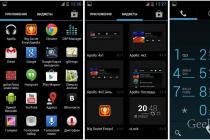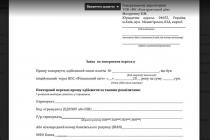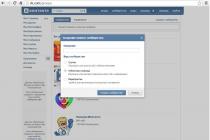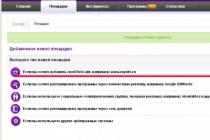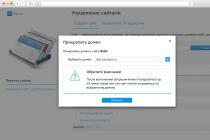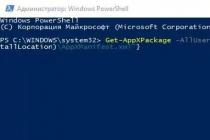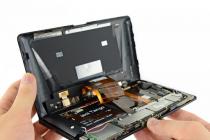Can do regular or low-level formatting hard disk as well as other external media. To do this, you just need to right-click on the desired object and select the "Format" menu item in the contextual branch.
But what exactly this utility does and what it is capable of in general remains a mystery to many. After checking, if a bad sector was found on the media, the program will not give you any notification, and it is quite possible that this problem cluster will continue to be used by the system.
In order to solve this problem, you have to resort to the help of third-party programs for low-level formatting hard drives and USB devices. Well, with the help of basic applications operating system"Windows" to unravel the secret of the sectors, alas, does not work.
So, we present to your attention best programs for low-level hard disk formatting, which can be found on the web. All of them have mostly a free or shareware license and are freely distributed through official or specialized resources.
It's worth noticing right away: before performing the low-level formatting hard disk, be sure to copy all important information to third-party media. Otherwise, you risk losing this data.
JetFlash Recovery Tool
This program for low-level formatting of hard drives will be an excellent help not only for working with a hard drive, but also with branded flash drives of this company, as well as devices of the ADATA trademark.

The utility allows you to carry out high-quality formatting of media or recover data from them. The application will be especially useful in the event that you have unreadable sectors, recording is completely disabled, or the disk is not recognized by the system.
Separately, it is worth mentioning the most simplified interface. Here you will not see confusing menu branches or incomprehensible icons, everything is very simple. There are two buttons: one for starting the data recovery procedure, and the other for "Exit".
The pickiness of the software acts as a fly in the ointment. That is, on the one hand, this is an excellent program for low-level formatting of hard drives, and on the other, we see only a narrow list of supported hardware. The lack of localization is difficult to write down as a minus, because even without the Russian language everything is very clear there.
HP Drive Key Boot Utility
Another sensible program for low-level formatting of hard drives and working with bad sectors. In addition, the utility perfectly "digests" the brands of flash drives "Kingston", "SanDisk" and "Transcend".

The application works smoothly in file systems such as FAT32, NTFS and ordinary FAT. That is, any storage capacity will be within the power of this program. One of the main advantages of the app is its intuitiveness. clear interface... All the main functionality of the program is concentrated in a single window, and you can perform all operations without leaving it. Pressing just a couple of buttons, you will see the inscription: "Low-level disk formatting completed" in a few minutes.
Distinctive features of the program
It is also useful to note the fact that this software can create boot disks using a built-in toolkit based on a copy of your operating system. The application itself goes to portable version, so there will be no problems with migration to other media and PCs.
By the minuses of the utility, users attribute mediocre support for the now popular SSD format, and in all other respects it is an excellent program for working with drives.
HDD Low Level Format Tool
This is a highly specialized utility, tailored specifically for working with media in such a "deep" way. HDD Low Level Format Tool is an excellent program for low-level formatting of Seagate, WD hard drives and almost any flash drive.

Before starting the procedure, you must select the desired media and then indicate the work plan. That is, here you can perform a quick cleaning of the hard drive or a complete low-level formatting of the hard drive.
One of the distinguishing features of the program is support for all types of hard drives, both conventional HDDs and high-speed SSDs, from any interface (IDE, SATA, SCSI, etc.). Also, the software does an excellent job with small flash brethren like mini or micro SD. Thanks to universal code the utility works on all known operating systems, including Windows.
The only fly in the ointment is the low processing speed. That is, for example, this low-level formatting program for a WD hard drive will be able to process this brand of hard drive at a speed of no more than 50 Mbps. The time to complete the operation will be significant, but it is more than compensated by the competent processing of sectors and tracks.
MiniTool Partition Home Edition
For the most part, this is a whole complex, distinguished by advanced functionality and appropriate usability. As for the specific possibilities, here they are practically limitless for hard drives.

In addition to basic layout operations, error checking, partition conversion and other things, there is a unique functionality inherent only in this software. We are talking about transferring an operating system from one media to another, selectively or completely copying information to another hard drive, in addition, judging by the reviews, this is a sensible wizard for recovering lost data.
Also, the software can easily work not only with single hard drives, but also with large RAID arrays. Separately, it is worth mentioning the speed of the application, where MiniTool Partition Wizard Free compares favorably with its counterparts.
Features of the software
All operations can be performed using both the familiar visual panel and the graphical menu. The developer, alas, did not foresee the official localization into Russian, but on the Web you can find quite competent Russifiers that are in no way inferior in quality to the stock ones.

As for compatibility and some updates, the developer is anxiously watching his product, so the application can be called universal through and through, and users did not notice any glitches or glitches.
In general, this is a worthy product that should be in the arsenal of any system administrator or an advanced user. Some may be upset by a paid distribution license, but for isolated cases a shareware period is provided, where within 30 days you can use all the features of the program, which should be enough to troubleshoot a drive.
Disk Storage Format Tool
This is a fairly powerful and fully functional utility for working with hard drives and flash drives of all brands and types. In addition, the program is distributed completely free of charge. There is also an advanced paid version, but it differs from the base one in its exterior rather than in some critical additions in terms of functionality.

The software feels great on the Windows platform of all versions - from XP to dozens, and no compatibility problems were noticed.
The utility is very easy to use, and the interface is intuitive even for a novice user. To get started, you need to specify the drive you want to work with, then go to the action menu, where you need to select what exactly you want to do for the disk, that is, format or fix errors.
Features of the utility
The program is competent in finding bad or unreadable sectors and their subsequent correction. A separate button is used to work with USB-flash drives, where error correction or low-level formatting of the media is also available.
Another advantage for which the utility is so fond of advanced users is the maintenance of detailed logs. All operations with a hard disk or flash drive will be reflected in a well-written report, where every step taken by the program is visible.
It is also worth mentioning the trouble-free work with other, more finicky media: mini- and micro-SD cards, SDXC and NS formats, as well as rare Compact Flash. The disadvantages include the lack of functionality for creating bootable disks and clumsy localization. But taking into account the available software functionality and free license all these shortcomings are practically leveled.
To completely clear a partition or a connected external media from files, a procedure such as formatting is often used. Novice users sometimes confuse it with deletion, but they are not the same thing. Formatting implies casting logical structure disk to a certain order, without which recording, storage and deletion of data is impossible. In the process of formatting, the file structure of the media is recreated, the MFT table containing information about the files is reset, while nothing of the kind happens during a regular delete or even a shredder using the method of multiple rewriting.
What is low-level formatting and how it differs from regular formatting
Formatting can be fast or slow, there is also high-level and low-level formatting. This last one will be discussed today. To be fair, it should be noted that the concept of low-level formatting is somewhat distorted today. Previously, it meant dividing a disk into tracks and sectors, as well as applying special electronic labels on a magnetic surface, called servo labels. All this is done exclusively on special factory equipment (servowriter).
The first HDDs were imperfect, they expanded under the influence of temperatures, which caused the sectors to shift relative to the read heads. For this reason, they needed a repeated servo marking procedure. In new disks, thermal expansion is compensated by recalibrating the parameters of the disk heads at the software level, and the servo labels themselves are applied once. Only such hardware formatting is most correctly called low-level formatting, however, over time, the concept has spread to software formatting as well.
Today, low-level formatting is understood as the irreversible destruction of all data on the carrier, including part of the service information by sequentially overwriting all sectors with zeros. The usual is now called quick format, in which only the MFT is cleared, the data itself remains physically on the disk. Low-level, or better to say, pseudo-low-level hard disk formatting solves the following tasks:
- Deleting all user data before selling the computer or media.
- Removal of some types of boot viruses (bootkits).
- High-quality disk cleanup before reinstalling the operating system.
- Correction of logical errors, treatment of bad sectors, provided that their appearance is not caused by media wear or damage.
- Prevention of the disk, bringing its logical structure to the proper state.
Features of formatting a hard drive and flash drive
From a technical point of view, there is a slight difference between formatting HDD and media based on flash memory, but for the user this does not of great importance... Regular or low-level formatting of a flash drive is performed with the same software tools that are used to format regular hard drives. The exceptions are cases when the USB flash drive cannot be formatted. standard means or even third party programs, which will be briefly discussed below.
If a flash drive is defined as a device with zero capacity or as an unknown device, it gives read / write errors that cannot be corrected by other methods, it is recommended to use special proprietary utilities to format it, which can usually be downloaded directly from the official website of the manufacturer of the flash device. All of the above is also true for low-level formatting of SD cards.
The best low-level formatting software
In principle, such formatting can be done using Windows itself by running the utility in the command line Diskpart and running the command for the selected drive clean all, but it is still better to use special programs for these purposes.
Perhaps the most famous program for low-level formatting of hard drives HDD / SSD, flash drives and memory cards. The utility is free, lightweight, simple interface, supports SATA, IDE, SCSI, USB and Firewire. Additionally, the program supports Ultra-DMA mode, viewing disk information and S.M.A.R.T. In the process of formatting, the HDD Low Level Format Tool completely destroys all data on the disk, including the MBR and the contents of the partition table, filling each sector or memory cell with zeros.
The utility is easy to use. After connecting the problematic media to the computer, select it in the program window and click the "Continue" button. In the next window, switch to the "Low-Level Format" tab and click "Format This Device".

The low-level formatting process will start. Along the way, you will be able to monitor the progress: how many sectors have been processed, how many percent are left until the completion of the operation, and also at what speed it is being performed. After formatting, disks become un-initialized.
 SeaTools for DOS and SeaTools for Windows
SeaTools for DOS and SeaTools for Windows
You can completely clean your drive or flash drive using the SeaTools diagnostic tool. The program is tailored for Seagate drives, but it can also work with drives from other manufacturers. The application supports work with SATA interfaces, USB, 1394, PATA, IDE and SCSI, perform media structural check, controller and system memory tests. Formatting is an optional feature.

To erase a disk or flash drive, from the SeaTools menu, select Advanced - Full Erase, after which low-level formatting will begin, during which all sectors will be overwritten with zeros.

SeaTools is distributed in two editions: For DOS and For Windows. Unlike the second, which is a desktop application, the first edition is bootable ISO image... Both versions support Russian, but by default the program interface is English.
Western Digital Data LifeGuard Diagnostics
Another proprietary diagnostic tool that allows you to format digital media with high quality.

The program supports reading S.M.A.R.T. readings, viewing detailed information about the connected media. It is very easy to use it as a shredder. Double-click on the medium selected in the utility window, click "Erase", and then "Start".

As a result, all sectors of the disk will be filled with zeros, that is, it will be low-level formatted.
Low-level hard disk (HDD) formatting is applicable to transmission interfaces, including SATA, as well as IDE, which operate at a low access level.
However, it is necessary to immediately make a reservation: when they talk about formatting at a low access level, they mean the "new" technological process of "zeroing" the hard drive. In this case, data from the surface of the device is erased and replaced with zeros using a special software... Previously, low-level formatting meant a completely different process.
Why do I need Disk Cleanup?
Most often complete cleaning hard SATA or ATA (IDE) drive is performed for the following reasons:
The question actually arises: why resort to such reformatting methods, what are the reasons for the disk processing at a low access level?
- getting rid of malicious programs, viruses that cannot be eradicated by other, less effective methods: anti-virus protection, scanning and destruction of corrupted data.
- for a "cleaner" reinstallation of the system, high-quality installation of applications on a fresh OS Windows, Mac OS or Linux.
- low-level formatting can be used to securely erase private, personal data that can be easily recovered using appropriate resuscitation applications
- one of the most justified reasons - "cure", prevention of bad sectors of the hard drive, removal of bad blocks, bad cylinders, which significantly impair the performance of the HDD
- if you are using a new storage device that does not work without first formatting
- if damaged boot sector: that is, the disk does not function as a boot device, but it is available to store information
- when reading errors occur during low-level file operations performed on the HDD
- for prophylaxis, diagnostics of a hard disk, bringing its structure, surface to the proper condition, suitable for correct reading and writing of information
- when reviving the hard drive, this is the most efficient way of the possible
The design of the hard disk allows the use of unused "spare" sectors to replace bad (bad) blocks. However, in practice, the HDD may simply not use this backup feature and continues to write, read information to and from bad sectors.
Therefore, low-level hard disk formatting allows you to instruct it to discard the bad cylinders, replacing them with spare ones. This, in general, significantly improves the performance of the drive, especially for SATA and IDE storage devices that have been in use for a long time, while standard formatting methods do not lead to the desired results of an acceptable level.
Which program to format the disk at a low level?
Note... If you decide on this procedure, I advise you to first make a backup - that is, a backup copy of important files and user data, programs - since after formatting the data will be destroyed irrevocably.
A small free program HDD Low Level Format Tool which supports a huge list of SATA- and IDE- hard drives (with rare exceptions).
Of course there are staff funds... For example, some BIOS's have a low-level formatting option for the hard drive. However, the disadvantage of this method is the low quality and even inadequacy of such methods. Some HDD manufacturers provide their own tools that address the hard drive at a low level, but this is a very narrow niche ... Therefore, it is relatively safer to use HDD Low Level Format by downloading the program through my catalog.


Using the SeaTools for DOS Utility to Format
I present to you an excellent low-level formatting utility - SeaTools for DOS. You can download it for free from the HDD vendor's website. The functionality of SeaTools includes three methods of HDD formatting, which are separately of interest to both home and professional users. The utility will be useful for eliminating numerous problems associated with bad sectors, bad blocks, sudden damage to the structure or systematic losses. important information on disk.
One of the important "tricks" of the program is that it really functions at a low- (low) level, works from under DOS, with its help it is easy to work in the interface command line... The program works quite fast - try scanning the disk surface with it, this operation takes only a couple of minutes.
After scanning and diagnosing problems, you can proceed to the actual hard low-level formatting of the disk by choosing the required method of deleting information.
Greetings!
In certain situations, it becomes necessary to perform low-level formatting of the HDD (hard disk), for example, by formatting it at a low level, the data on it will be irrevocably (without the possibility of recovery, including special utilities) deleted. This can be useful in a situation where you want to sell a computer, but do not want to have even a theoretical probability of recovering data that was once on the hard drive.
Also, using low-level formatting, you can try to "cure" the bad sectors on the hard disk.
During low-level formatting, bad sectors (so-called bad blocks) are marked as unusable. However, it is worth remembering that this procedure is not a panacea for the appearance of new bad blocks during the use of the hard disk.
In general, it is worth taking as a rule - if the disk begins to "fail" and unreadable blocks (bad-blocks) began to appear on it, then there is a risk of eventually losing all the data on it at once.
If the disc is under warranty, then immediately return it - this is warranty case... If the warranty has passed, then after the "treatment" carried out, store only not very important data on it, for example, movies and music.
If we talk about Flash - disks (flash drives), then the low-level formatting procedure in some cases can revive the "faulty" storage medium.
This formatting method is not recommended for SSD drives. Fundamentally different solutions are used to work with this type of media.
HDD Low Level Format Tool
Despite the fact that there are a sufficient number of programs of this kind, including some official applications from manufacturers of HDD and Flash drives, I still recommend using one of the best universal utilities of such kind - .

This utility differs from similar simplicity of management and ease with which it performs low-level formatting of hard drives, flash cards and drives. Thanks to a simple and intuitive interface, mastering this utility is within the power of a novice user.
The utility is paid, but in free mode the program works in full-featured mode with only one exception: the maximum speed of low-level formatting is 50 MB / s.
For example, in the free mode of operation HDD Utilities Low Level Format Tool low level formatting HDD disk and with a volume of 640 GB it lasted about 2 hours. Sometimes, however, the speed dropped significantly below the stated 50 MB / s.
Key features:
- work with media connected via: IDE, SATA, USB, SCSI, Firewire is supported;
- HDD drives are supported: Seagate, Western Digital, Hitachi, Maxtor, Samsung, etc.
- Supports low-level formatting of USB and Flash-cards (via card reader).
With low-level formatting, all data on the disk will be irrevocably destroyed! The program supports working with disks that are connected via USB and Firewire interfaces. In other words, you can do low-level formatting and try to bring even classic USB sticks back to life.
Low-level formatting will delete the MBR, the partition table from the disk. An attempt to recover data from a disk formatted in this way is unlikely to be successful even when contacting a service that specializes in data recovery. In this regard, be extremely careful and careful when working with this software.
When is low-level formatting applied?
Low-level formatting is most often used for the following reasons:
- As mentioned above, one of the most common reasons is getting rid of errors and "healing" the hard drive. In the process of low-level formatting, bad (unreadable) blocks are marked as bad and are excluded from subsequent use. This somewhat improves the reliability of the SATA or IDE hard drive and extends its lifespan.
- There was a need to reliably destroy (without the possibility of recovery) the existing data on the hard disk data, for example, to sell it separately or as part of the entire computer. However, for this task it is better and more correct to use the appropriate solution - for, for.
- Sometimes this method is used to completely destroy various kinds of viruses and malicious elements (registering themselves in the boot area, etc.), which are difficult to get rid of in any other way.
- In some cases, the need for low-level formatting arises when moving from the operating room Linux systems on Microsoft Windows.
- In some cases, this procedure helps to "revive" a faulty USB flash drive. For example, when it is impossible to write anything to it and format it by standard means in Windows, it also fails.
- When connecting a new drive, although in this situation, normal formatting is often enough.
Low-level formatting of a Flash disk (flash drive) \ HDD
Important nuances:
1) The hard disk drive (HDD) is formatted in exactly the same way as the flash drive shown in the example.
And yes, the flash drive is the most common, made in China. The reason for the low-level formatting: when connected, it ceased to be displayed in the system. However, the HDD Low Level Format Tool detected it, and it was decided to try to "cure" it.
2) Low-level formatting is possible both under Windows and under DOS, however, with some caveats. A fairly common mistake, especially among novice users, is an attempt to format the disk from which the operating system was booted. In other words, if you have one single computer installed HDD and it has, for example, an operating room installed Windows system- then to directly format this disc, you need to boot from another medium, for example, Live-CD. Or you can connect your HDD to another computer (or laptop) and perform low-level formatting from there.
We are done with the nuances, now we will look at the very process of low-level formatting using the HDD Low Level Format Tool utility.
There are two versions of this utility - the first requires installation, and the second is portable (works without installation). Choose the option that works best for you.

1) After starting the program, a window will appear with a welcome message and a proposal to register it. The free use case differs from the paid one only in that the low-level formatting does not take place at full speed. Agree that this formatting procedure does not have to be resorted to so often, and therefore often a free use case is enough. To continue working with the program, click the button Continue for free, which loosely means continue for free.

2) Next, you will see a window in which all connected drives found by the program will be listed. Keep in mind that disks are designated here in a special way: instead of the usual C: \ .. D: \, etc. in the window are displayed directly by themselves physical disks... And, accordingly, it is necessary to navigate here by the name and volume of the drive.
To continue, select the desired drive and press the button Continue >>>(proceed).

3) As a result, a window should appear with three tabs. In the Device details tab, you can underline information about the selected drive, and in the S.M.A.R.T. find out the health parameters of the drive. The start of the low-level formatting procedure is carried out in the tab LOW-LEVEL FORMAT.
Having opened this tab, click on the button located there FORMAT THIS DEVICE(format this device).
Note: if you check the box opposite the Perform quick wipe ... item, the usual formatting will be performed for the place of the low-level formatting.

4) Next, a warning will appear, the essence of which boils down to the fact that all data on the media will be permanently deleted during the formatting process. Check again, just in case, if there is any important data left on the drive. If there are none, then press the corresponding button to start the procedure.

5) The low-level formatting process begins. During this period, you cannot turn off or remove the USB flash drive / disk, try to open the media in the file manager, and even more so try to write something to it at the time of formatting. It is best not to run any resource-intensive programs and applications during this period and not to use the computer at all until the end of the formatting.
When the progress bar reaches 100%, formatting is complete. You can close the program.
An important caveat: the time it takes to format the drive depends on several factors: the mode of operation of the utility (paid or free), as well as the state of the drive itself. If there are a lot of errors (unreadable sectors) on it, then the process will take some time and you will have to wait ...
After the carried out low-level formatting, all information on the disk will be deleted, the tracks and sectors will be marked, some service and Technical information... Naturally, you will not be able to access this disc yet, and you will not see it with most programs either. This disc needs a formatting procedure high level, during which the file table is created, etc.
In order to carry out high-level formatting, you can use the standard feature offered by the Windows operating system. The hard disk is formatted in the window system tool since from file manager the disc after low-level formatting disappears. If we are talking about a USB flash drive, then just go to My computer(This computer) and right-click there on the required disk (if, of course, it is visible), and in the displayed context menu select the item Format… In particular, the flash drive used in the review began to be displayed in the system after the "treatment" was carried out.

In the window that appears, you will need to select file system: for HDD (hard drives) it is exclusively NTFS, and for flash drives it is quite possible to choose and FAT(provided that you will not try to write a file to it that is more than 4 GB in size).  Optionally, you can enter a volume label. Then click on the button Begin.
Optionally, you can enter a volume label. Then click on the button Begin.
At the end of this procedure, you can use your data carrier again. However, never forget to back up your data, especially from media that have made you doubt their reliability.
Brief summary
In this article, we examined the low-level formatting procedure in detail, and the reasons for this operation were announced.
After reading it, you now know how to perform low-level formatting of a hard disk or flash drive (including one connected through a card reader).
If you have any questions, you can ask them in the comments.
Facebook Google plusHow do I low-level format a SATA or ATA (IDE) hard drive?
What does low-level formatting of a SATA or ATA (IDE) drive mean?
In fact, the term "low level" is not entirely correct. The low-level formatting process used many years ago to hard drives MFM has little to do with modern "low-level formatting" of SATA and ATA (IDE) drives. The only safe method to return your Seagate device to the initial state- complete deletion of data using the SeaTools for DOS program command. In this case, the entire hard disk space is simply filled with zeros (0).
Why do I need to wipe my hard drive?
Most often, a full wipe of a SATA or ATA (IDE) hard drive is performed for the following reasons:
- to remove a virus that cannot be removed without destroying the boot sector;
- to replace the operating system with complete deletion of data from the disk;
- to remove confidential personal information;
- when searching for bad sectors that can be detected and replaced with good ones when writing.
In the design of modern disk drives, additional redefined sectors are provided. Typically, sector data becomes difficult to read long before it becomes completely unavailable. In this case, when overridden, the actual data bytes in the sector are retained and transferred to the new spare sector. Likewise, when a problem occurs while writing data to a disk drive (such as a full wipe), the disk's firmware extracts the complex sector and replaces it before reporting a successful write completion.
How is the hard drive cleaned up?
- Erasing a SATA or ATA (IDE) drive deletes 100% of the data. Make sure you are in stock beforehand backup all data.
- It is best to use the command " Complete removal data from the SeaTools for DOS utility "for a Seagate hard drive. Some systems have low-level formatting capabilities in their BIOS, but are not recommended for use due to their unpredictable results.
SeaTools for DOS can be downloaded from home page SeaTools. It includes three cleaning options (complete deletion of data). The Wipe data command fills all data sectors on the disk with zeros and removes most defects.
The standard boot process for SeaTools for DOS creates a bootable CD or floppy disk. Boot from CD or floppy disk to launch SeaTools for DOS. After that, it is useful to check the disk. A short basic check takes less than a minute. A long basic check can take several hours, depending on the capacity of the drive. Prepared to clean up
Erase track 0: only clears the first 63 sectors on the disk, which takes less than a second. This removes the Master Boot Record (MBR) and the partition table. When installing a new operating system, the disk appears to be "empty".
Erase by time: erase sectors over a period of time (up to 5 minutes). These commands allow you to overwrite sectors at the beginning of the disk, where most of the operating system files are located.
Erase everything: deleting all data sectors from disk, taking a long time. The procedure often takes several hours. Its advantage is that you can detect and redefine all bad (poorly read) sectors and replace them with good spare. This option is closest to the original concept of low-level formatting.
Once the process is complete, reboot the system from the installation CD and follow the instructions for preparing the disk (partitioning and formatting) and installing the operating system.


